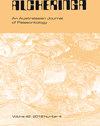Nummulites perforatus (de Montfort, 1808) and N. beaumonti: d’Archaic & Haime, 1853: a new record from Gebel Hafit, United Arab Emirates
IF 1.5
4区 地球科学
Q3 PALEONTOLOGY
引用次数: 0
Abstract
Al Menoufy, S. 20 June 2018. Nummulites perforatus (de Montfort, 1808) and N. beaumonti d’Archaic & Haime, 1853: a new record from Gebel Hafit, United Arab Emirates. Alcheringa 43, 146–156. Nummulites perforatus (N. burdigalensis group) and N. beaumonti (N. discorbinus group) are recorded from a Priabonian limestone outcrop of the Mazyad Member, Dammam Formation, exposed along the eastern limb of Gebel Hafit Anticline, in the United Arab Emirates. Nummulites perforatus at this site is characterized morphologically by lenticular to inflated-lenticular tests with rounded edges, meandering septal filaments, dense granules on, and between, the septal filaments, chambers that are longer than high and a regular-shaped spire. Biometric studies have demonstrated that this new material from the United Arab Emirates is similar to specimens of N. perforatus previously described. N. beaumonti is here characterized morphologically by lenticular tests with slightly rounded peripheries, a relatively thick and irregular marginal cord, compact septal filaments that are curved initially but become radial and twisted around the polar area with a slight flexure towards the periphery, tight to lax coiled spire, and chambers that are rectangular in shape and higher than long, including a rudimentary polar pustule. Biometric studies revealed that this material is comparable with specimens of N. beaumonti. Nummulites perforatus and N. beaumonti span the SBZ19 zone and are considered to be late Eocene (Priabonian) in age. Safia Al Menoufy [safiageo@yahoo.com or almenoufysafia@gmail.com] Biological & Geological Sciences, Faculty of Education, Ain Shams University, Roxy, El khalifa El maamoon Street, Cairo 11566, Egypt.穿孔Nummulites perforatus (de Montfort, 1808)和N. beaumonti: d 'Archaic & Haime, 1853:来自阿拉伯联合酋长国Gebel Hafit的新记录
Al Menoufy, 2018年6月20日。穿孔Nummulites perforatus (de Montfort, 1808)和N. beaumonti d 'Archaic & Haime, 1853:来自阿拉伯联合酋长国Gebel Hafit的新记录。Alcheringa 43, 146-156。阿拉伯联合酋长国Gebel Hafit背斜东侧Mazyad组达曼组Priabonian石灰岩露头记录了Nummulites perforatus (N. burdigalensis群)和N. beaumonti (N. discorbinus群)。此处穿孔数瓣的形态特征为透镜状或膨大透镜状,边缘圆润,间隔丝弯曲,间隔丝上和间隔间有致密颗粒,室高大于室高,有规则形状的尖顶。生物识别研究表明,这种来自阿拉伯联合酋长国的新材料与先前描述的N. perforatus标本相似。波蒙氏单胞菌的形态特征为透镜状,外周微圆,边缘索较粗且不规则,紧凑的间隔丝最初弯曲,但在极区周围呈径向扭曲,向外周有轻微弯曲,螺旋状尖顶紧或松,室形为矩形,较长,包括一个初步的极脓疱。生物计量学研究表明,这种材料与博蒙奈菌的标本相当。Nummulites perforatus和N. beaumonti跨越SBZ19带,年龄被认为是晚始新世(Priabonian)。Safia Al Menoufy [safiageo@yahoo.com或almenoufysafia@gmail.com]埃及开罗11566 El khalifa El maamoon街Roxy艾因沙姆斯大学教育学院生物与地质科学。
本文章由计算机程序翻译,如有差异,请以英文原文为准。
求助全文
约1分钟内获得全文
求助全文
来源期刊

Alcheringa
地学-古生物学
CiteScore
2.60
自引率
7.70%
发文量
28
审稿时长
>12 weeks
期刊介绍:
Alcheringa : An Australasian Journal of Palaeontology is the official journal of the Australasian Palaeontologists.
Alcheringa covers all aspects of palaeontology and its ramifications into the earth and biological sciences, including:
Taxonomy-
Biostratigraphy-
Micropalaeontology-
Vertebrate palaeontology-
Palaeobotany-
Palynology-
Palaeobiology-
Palaeoanatomy-
Palaeoecology-
Biostratinomy-
Biogeography-
Chronobiology-
Biogeochemistry-
Palichnology.
Review articles are welcome, and may be solicited from time to time. Thematic issues are also possible. Emphasis is placed on high quality and informative illustration, in both line drawings and photographs. Papers of general significance may receive preference over those of more local interest.
 求助内容:
求助内容: 应助结果提醒方式:
应助结果提醒方式:


